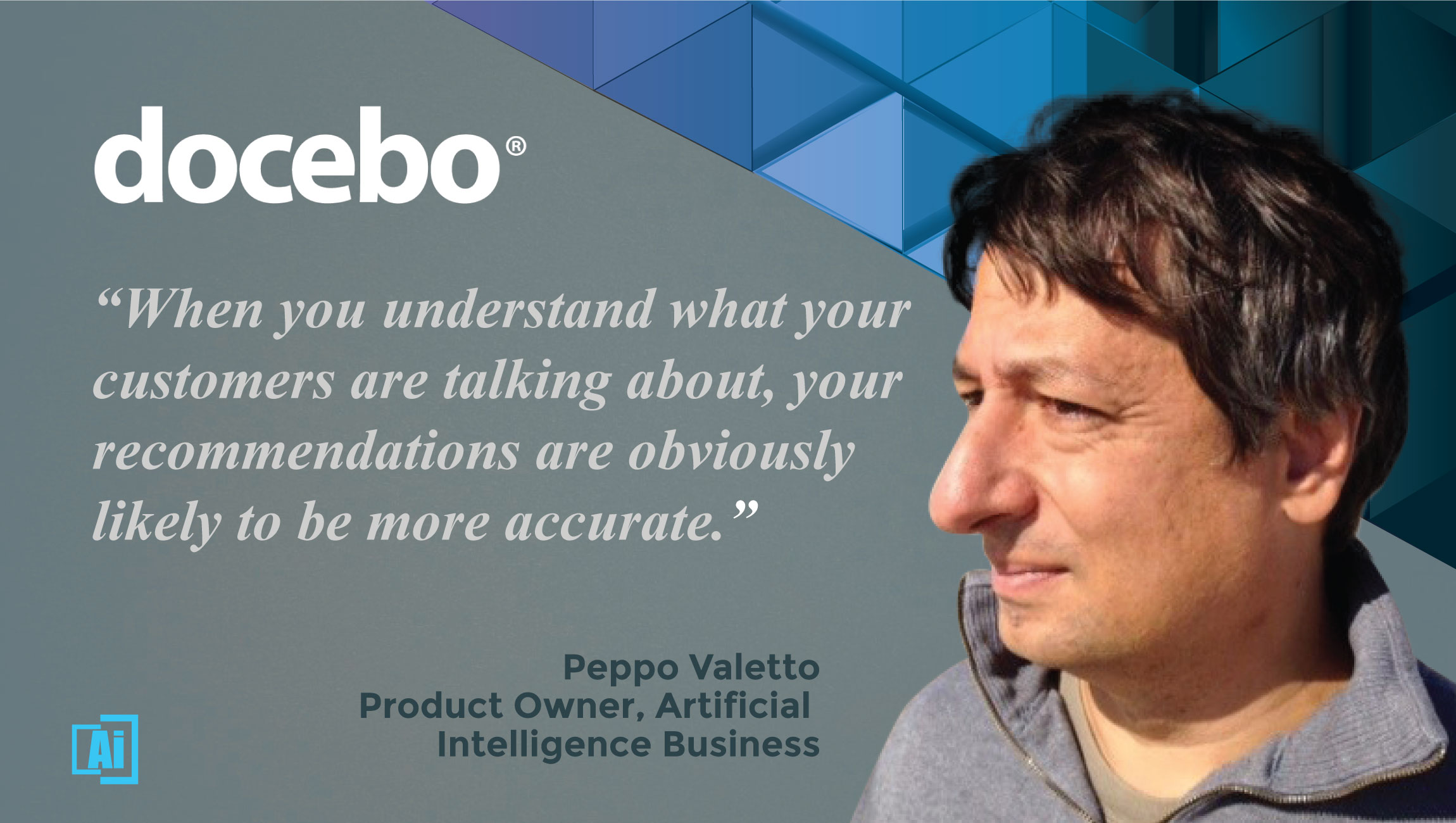AiThority Interview With Peppo Valetto, Product Owner of AI at Docebo

Tell us more about your AI applications and the team that works with it.
We started to build the team 3 years ago: we have hired a Team leader and Data scientists with years of experience in Research and we have rounded up the team incrementally with DataOps and Python SW Engineers to bring to production the data scientists’ algorithms and models
Some of our competitors are right now putting together recommendation systems, some describing them as “Netflix for learners.”
Instead, the first pipeline we have built has been about making sense of learning content; we call it automated content curation. There are so many applications and benefits of having sophisticated content analysis capabilities: from content tagging to categorization (e.g. vs the skills required of the Learner), summarization, topic modeling, automated answering, and Learners’ questions.
We are implementing all of those in our services. Also, when you understand what your customers are talking about, your recommendations are obviously likely to be more accurate.
Read More: AiThority Interview With Al Sporer, Executive VP and General Manager at Anexinet
What truly drives the AI-based LMS industry? What unique AI-driven stacks have you designed in the last 2 years that were nearly impossible to imagine 10 years ago?
The easy answer is data, like for other industries that are embracing Machine Learning and AI now. We can leverage large amounts of interaction data, plus, as mentioned above, learning contents are a prime source of data for the Docebo AI.
But, looking closely at the learning industry, the driving forces are three very specific needs:
1. The need for personalized learning experiences to heighten each learner’s engagement,
2. The need for learning that closely matches and remains relevant vs. the quickly changing training needs in today’s market, and
3. The need to help L&D managers in staying on top of the previous two imperatives.
That is why another area we are developing is Virtual Coaching, i.e., personalized assistance at scale, provided by an intelligent agent that follows and nudges each individual Learner along with his training experience, provides guidance on the best activities to do and paths to follow to reach her personal learning goals, help the learner recall important notions over time and as they are needed.
We have inserted the first release of our Virtual Coach in the Docebo LMS and Mobile app; over time, as we integrate more features, it is going to evolve in a completely novel way to interact with the learning platform, conversation-based, natural and proactive at the time of need.
It is going to be a big leap ahead with respect to how people used to interact with their LMS even only yesterday.
Read More: AiThority Interview With Tom Pendergast, Chief Learning Officer at MediaPRO
What technology-related factors have led to the massive disruption in the CMS and Cloud-based LMS platforms?
We opened an Ideas portal for all clients a few years ago, which has had a major impact on how we collect and implement feedback on not only our product but also the services and processes around our product.
Last month, we released features in our product that had more than 500 combined customer votes, so customer feedback is one of the main drivers of our product.
It’s important for us that our customers feel heard and feel as if they’re part of the Docebo family, so giving them a space to voice their opinions and enhance the experience of all Docebo customers is a vital part of how we run our business.
Read More: AiThority Interview with Ben Vaught, CEO at DemandStar
Hear it from the pro: How to use customer feedback to build a better product? How often do you provide feedback to your Product Development and Marketing teams?
Docebo has an ‘Ideas’ portal, where actual platform users post product enhancements and new feature ideas that are voted by other users and Docebo teams. These ideas are analyzed by a product committee every week, and, if adhering with the overall Product strategy, planned for release.
Docebo is committed to releasing at least one improvement or a new feature in the platform each month that ties back to a customer idea. Larger refactoring and redesign, such as Custom Reports, combined several customer ideas into a wider initiative.
Docebo also conducts an annual user conference which provides the users a tremendous opportunity to get together, share ideas and feedback for the platform which assists us in further improving the platform.
Our Product Marketing team is always hard at work sharing information and providing feedback between our Marketing and Product development teams.
Thank you, Peppo! That was fun and we hope to see you back on AiThority.com soon.
Giuseppe Peppo Valetto is the Product Owner of Artificial Intelligence at Docebo. He is an experienced researcher with a demonstrated history of working in the learning industry. He leads Docebo’s AI team in developing the first AI-powered learning platform.
Docebo is powered by Artificial Intelligence (AI) and based on the 70/20/10 learning framework, providing organizations and their partners/customers around the world to deliver unparalleled automated and personalized learning experiences that turn learning into a competitive advantage. Recognized for its ability to satisfy multiple use cases for both internal and external enterprise learning, the Docebo learning platform is now used by more than 6 million users at 1,700 organizations in over 68 countries.









Comments are closed.